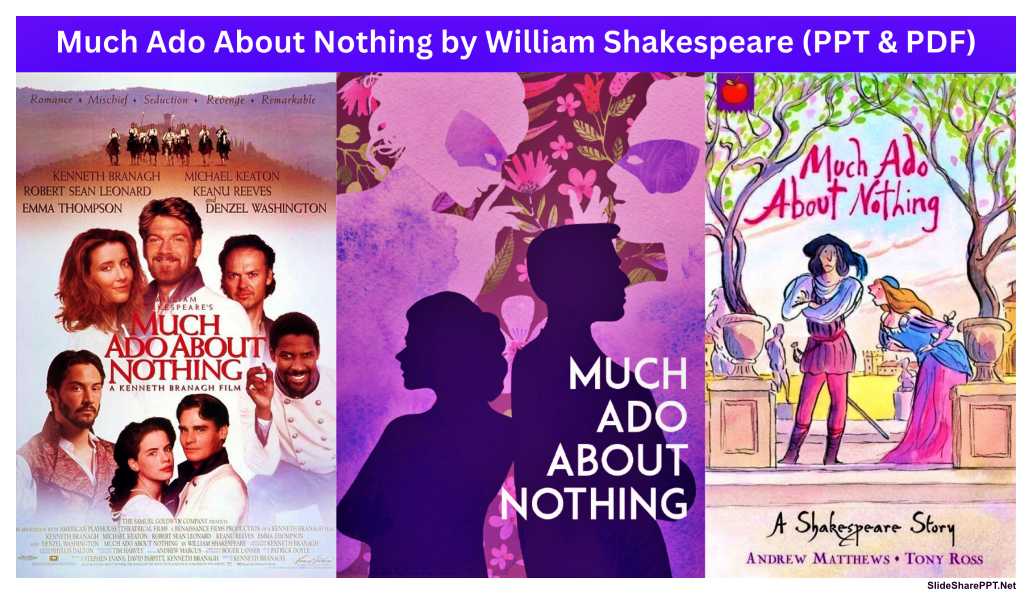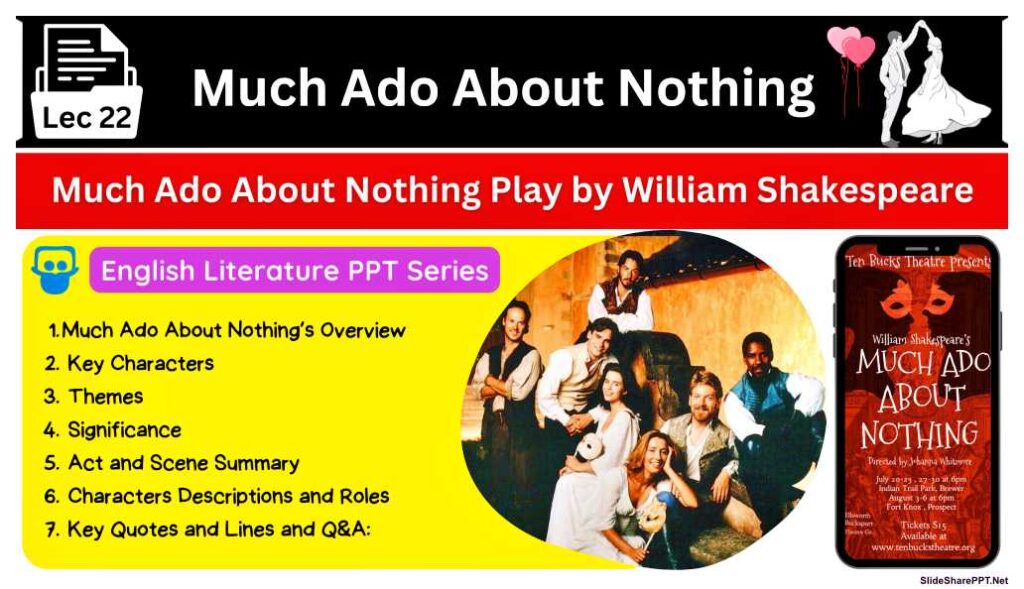Much Ado About Nothing PPT Slides & PDF Download
Today we have shared the Notes of William Shakespeare’s Famous Play Much Ado About Nothing PPT Slides & PDF Download, So as we know William Shakespeare’s “Much Ado About Nothing” stands as a timeless masterpiece in the world of literature, captivating audiences for centuries with its blend of wit, humor, and romance. Written in the late 16th century, this comedic play continues to resonate with modern audiences, exploring themes of love, deception, and societal expectations with unparalleled depth and complexity. As we delve into the intricacies of this beloved work, we uncover layers of meaning and relevance that make it a perennial favorite among theater enthusiasts and scholars alike.
About the Much Ado About Nothing
Here’s a complete table for “Much Ado About Nothing”:
| Aspect | Description |
|---|---|
| Title | Much Ado About Nothing |
| Playwright | William Shakespeare |
| Genre | Comedy, romantic comedy |
| Date of Composition | Estimated to be between 1598 and 1599 |
| Setting | Messina, a town in Sicily, Italy |
| Main Characters | Beatrice, Benedick, Claudio, Hero, Don Pedro, Don John, Leonato, Dogberry, Verges, Margaret, Borachio |
| Plot Overview | The play centers around two couples: Beatrice and Benedick, who engage in a witty war of words while denying their love for each other, and Claudio and Hero, whose budding romance is threatened by malicious schemes. Through a series of misunderstandings and deceptions orchestrated by the villainous Don John, the characters navigate the complexities of love and honor, ultimately leading to a joyous resolution. |
| Key Themes | Love and deception, gender roles and expectations, the power of language, honor and reputation |
| Significance | “Much Ado About Nothing” is celebrated for its sparkling wit, lively banter, and memorable characters. It is one of Shakespeare’s most beloved comedies, exploring themes of love, jealousy, and the intricacies of human relationships. |
| Notable Lines | – “I do love nothing in the world so well as you. Is not that strange?” (Act 4, Scene 1) – “Some Cupid kills with arrows, some with traps.” (Act 3, Scene 1) – “For which of my bad parts didst thou first fall in love with me?” (Act 5, Scene 2) |
| Adaptations | “Much Ado About Nothing” has been adapted into various stage productions, films, and television adaptations. Notable adaptations include the film directed by Kenneth Branagh (1993) and numerous stage productions by theater companies around the world. |
This table provides a comprehensive overview of various aspects of “Much Ado About Nothing,” including its background, plot, characters, themes, significance, notable lines, and adaptations.
Much Ado About Nothing PPT Slides
(Lecture 22)
Important:-
- If you are viewing this PPT on your phone, please make it full screen and then view it. (Press: 3 dots in PPT, then Full Screen)
- If you have a problem while clicking on next, (Just tap) on the slide instead of clicking Next Botton.
- FOR A BETTER VIEW PRESS Ctrl + Shift + F ON A PC OR LAPTOP.
- Whatever is written in the PPT is different and whatever is written below is different.

Note: The complete Text PDF Link is at the end of the PowerPoint slides (go to the last PPT Slide)
Much Ado About Nothing
“Much Ado About Nothing” by William Shakespeare is a delightful comedy that revolves around the complexities of love, deception, and misunderstanding. Set in the town of Messina, the play unfolds over a series of misunderstandings, schemes, and romantic entanglements.
- The play opens with the return of Don Pedro, the Prince of Aragon, from a victorious battle. Accompanying him are his close friends, Claudio and Benedick. Claudio falls in love with Hero, the daughter of Leonato, the governor of Messina. Meanwhile, Benedick and Beatrice, Hero’s cousin, engage in a witty and spirited battle of wits, masking their true feelings for each other.
- The plot thickens when Don John, Don Pedro’s illegitimate brother, conspires to ruin Claudio and Hero’s budding romance out of spite. He orchestrates a deceptive plot that leads Claudio to believe that Hero has been unfaithful to him. At their wedding ceremony, Claudio publicly shames Hero, accusing her of infidelity and causing her to faint in shock. She is believed to be dead, and the truth of her innocence remains hidden.
- Amidst the chaos, Dogberry, the bumbling constable of Messina, and his watchmen stumble upon the truth of Don John’s villainous plot. They apprehend the perpetrators, and Borachio, one of Don John’s accomplices, confesses to the scheme. Hero’s innocence is revealed, but the damage to her reputation and the trust between her and Claudio has been done.
- The resolution of the play comes with the exposure of Don John’s villainy and the restoration of Hero’s honor. Claudio, remorseful for his actions, agrees to marry Leonato’s “niece,” who is revealed to be Hero herself, disguised as a stranger. Beatrice and Benedick also declare their love for each other, having been tricked into admitting their true feelings by their friends.
In the end, the play concludes with a double wedding ceremony, as Claudio and Hero are reunited, and Beatrice and Benedick commit to each other. Don John’s villainy is exposed, and he flees to avoid punishment. The play ends with celebrations and rejoicing, as the characters reflect on the triumph of love over deception and the restoration of honor and happiness in Messina.
Conclusion: “Much Ado About Nothing” remains a beloved classic in the world of literature and theater. With its vibrant characters, witty dialogue, and timeless themes, this Shakespearean comedy continues to entertain and inspire audiences around the globe. Whether enjoyed on stage or on the page, the play’s enduring charm ensures its place as one of Shakespeare’s most cherished works.
Key Characters
Here’s a complete table outlining the key characters in William Shakespeare’s “Much Ado About Nothing”:
| Character | Description |
|---|---|
| Beatrice | A sharp-witted and independent woman, Beatrice is known for her quick wit and disdain for love. She engages in a battle of wits with Benedick, which eventually blossoms into romance. |
| Benedick | A witty and sarcastic nobleman, Benedick is known for his aversion to marriage. He engages in banter with Beatrice but ultimately falls in love with her. |
| Hero | A gentle and virtuous young woman, Hero is the cousin of Beatrice. She is betrothed to Claudio but becomes the victim of a malicious plot orchestrated by Don John. |
| Claudio | A young nobleman and soldier, Claudio is in love with Hero. He is manipulated into believing that Hero has been unfaithful to him, leading to turmoil and misunderstanding. |
| Don Pedro | The Prince of Aragon, Don Pedro is a respected nobleman and military commander. He plays a central role in the romantic entanglements of the other characters. |
| Don John | The villainous half-brother of Don Pedro, Don John harbors resentment and seeks to sow discord among the other characters. His schemes drive much of the conflict in the play. |
| Leonato | Hero’s father and the governor of Messina, Leonato is a respected and honorable man who becomes embroiled in the drama surrounding his daughter’s reputation. |
| Margaret | Hero’s maid and a friend of Beatrice, Margaret unwittingly becomes involved in the plot against Hero and Claudio. |
| Dogberry | The comically inept constable of Messina, Dogberry, and his watchmen inadvertently uncover the villainous plot against Hero, albeit in a bumbling manner. |
Themes
Here’s a complete table outlining the key themes in William Shakespeare’s “Much Ado About Nothing”:
| Theme | Description |
|---|---|
| Deception and Misunderstanding | Deception and misunderstanding drive much of the plot in “Much Ado About Nothing.” Characters are deceived by malicious plots, mistaken identities, and false accusations, leading to confusion and conflict. The theme explores the consequences of deception and the importance of honesty and communication in relationships. |
| Love and Romance | Love and romance are central themes in the play, as characters navigate the complexities of romantic relationships. From the witty banter between Beatrice and Benedick to the tumultuous courtship of Claudio and Hero, Shakespeare explores various aspects of love, including courtship, betrayal, and forgiveness. |
| Honor and Reputation | Honor and reputation are highly valued in the society depicted in “Much Ado About Nothing.” The characters’ reputations are constantly at stake, and accusations of impropriety can have serious consequences. The theme explores the fragility of honor and the lengths to which characters will go to protect their reputations. |
| Gender Roles | Gender roles and expectations are explored through the characters of Beatrice and Hero, who represent contrasting ideals of femininity. Beatrice challenges traditional gender norms with her independence and wit, while Hero embodies the virtues of chastity and obedience. The theme highlights the limitations imposed by societal expectations and the agency of women in Renaissance society. |
| Appearance vs. Reality | “Much Ado About Nothing” delves into the contrast between appearance and reality, as characters are not always what they seem. Deceptions and misunderstandings arise from false appearances, leading to dramatic revelations and character development. The theme underscores the importance of discerning truth from illusion in a world where perceptions can be deceiving. |
| Social Class | Social class plays a role in the dynamics between characters in “Much Ado About Nothing.” The play portrays the social hierarchy of Renaissance society, where distinctions of rank and status influence relationships and interactions. The theme explores issues of power, privilege, and social mobility in a stratified society. |
Significance
Here’s a complete table outlining the significance of William Shakespeare’s “Much Ado About Nothing”:
| Significance | Description |
|---|---|
| Exploration of Love and Courtship | “Much Ado About Nothing” is renowned for its exploration of love and courtship, showcasing various forms of romantic relationships, from the witty banter between Beatrice and Benedick to the tumultuous courtship of Claudio and Hero. |
| Examination of Deception and Misunderstanding | Deception and misunderstanding drive much of the plot in the play, highlighting the consequences of deception and the importance of honesty and communication in relationships. The theme underscores the fragility of trust and the power of false appearances. |
| Introduction of Memorable Characters | The play introduces audiences to memorable characters such as Beatrice, Benedick, and Dogberry, who have become iconic figures in literature and theater. These characters embody wit, humor, and complexity, contributing to the enduring popularity of the play. |
| Exploration of Gender Roles | “Much Ado About Nothing” challenges traditional gender roles through characters like Beatrice, who defies societal expectations with her independence and wit. The play explores issues of agency, autonomy, and gender dynamics in Renaissance society. |
| A blend of Comedy and Drama | Shakespeare masterfully blends comedy and drama in “Much Ado About Nothing,” creating a work that is both entertaining and thought-provoking. The play features humorous moments of wit and slapstick alongside poignant scenes of romance and intrigue. |
| Enduring Popularity | “Much Ado About Nothing” has remained popular for centuries, captivating audiences with its engaging plot, memorable characters, and timeless themes. Its universal appeal and rich language continue to make it a favorite among theatergoers and readers worldwide. |
These points illustrate the enduring significance of “Much Ado About Nothing” as a timeless work of literature and theater, exploring themes of love, deception, and gender dynamics with wit, humor, and insight.
Act and Scene Summary
Here’s a table providing a summary of each act and scene in William Shakespeare’s “Much Ado About Nothing”:
| Act | Scene | Summary |
|---|---|---|
| Act 1 | Scene 1 | The play opens with Don Pedro, the Prince of Aragon, returning from a victorious battle accompanied by his followers, including Claudio and Benedick. They arrive at the house of Leonato, where Claudio falls in love with Hero, Leonato’s daughter. Meanwhile, Benedick engages in witty banter with Beatrice, Leonato’s niece, showcasing their mutual disdain for love. |
| Act 2 | Scene 1 | Don John, the illegitimate brother of Don Pedro, plots to ruin Claudio’s budding romance with Hero out of spite. He informs Claudio that Don Pedro is wooing Hero for himself, leading Claudio to misunderstand the situation and become despondent. |
| Act 3 | Scene 1 | Claudio and Don Pedro, believing they have seen evidence of Hero’s infidelity, confront her publicly on her wedding day, humiliating her and breaking off their engagement. Hero faints in shock, and she is believed to be dead. Meanwhile, Dogberry and the watchmen capture Borachio, who confesses to being part of Don John’s plot to deceive Claudio and ruin Hero’s reputation. |
| Act 4 | Scene 1 | Hero’s innocence is proven when Borachio’s confession is revealed, and Claudio mourns her apparent death. Leonato agrees to Claudio’s request to marry his “niece,” who turns out to be Hero, disguised as a stranger. Beatrice and Benedick confess their love for each other, and Don Pedro conspires with Leonato to bring them together. |
| Act 5 | Scene 1 | The play concludes with a double wedding ceremony: Claudio and Hero are reunited, and Beatrice and Benedick proclaim their love publicly. Don John’s villainy is exposed, and he flees to escape punishment. The festivities continue as the characters celebrate the restoration of honor and the triumph of love over deception. |
Characters Descriptions and Roles
Here’s a table providing descriptions and roles of key characters in William Shakespeare’s “Much Ado About Nothing”:
| Character | Description and Role |
|---|---|
| Beatrice | Beatrice is a sharp-witted and independent woman, known for her quick wit and disdain for love. She engages in a battle of wits with Benedick, which eventually blossoms into romance. |
| Benedick | Benedick is a witty and sarcastic nobleman who is known for his aversion to marriage. He engages in banter with Beatrice but ultimately falls in love with her. |
| Hero | Hero is a gentle and virtuous young woman, the cousin of Beatrice. She is betrothed to Claudio but becomes the victim of a malicious plot orchestrated by Don John. |
| Claudio | Claudio is a young nobleman and soldier who is in love with Hero. He is manipulated into believing that Hero has been unfaithful to him, leading to turmoil and misunderstanding. |
| Don Pedro | Don Pedro is the Prince of Aragon, a respected nobleman and military commander. He plays a central role in the romantic entanglements of the other characters. |
| Don John | Don John is the villainous half-brother of Don Pedro, who harbors resentment and seeks to sow discord among the other characters. His schemes drive much of the conflict in the play. |
| Leonato | Leonato is Hero’s father and the governor of Messina. He is a respected and honorable man who becomes embroiled in the drama surrounding his daughter’s reputation. |
| Margaret | Margaret is Hero’s maid and a friend of Beatrice. She unwittingly becomes involved in the plot against Hero and Claudio. |
| Dogberry | Dogberry is the comically inept constable of Messina. He and his watchmen inadvertently uncover the villainous plot against Hero, albeit in a bumbling manner. |
| Don Antonio | Don Antonio is a minor character in the play, often overlooked. He is introduced in the masque scene where Beatrice and Benedick are tricked into confessing their love for each other. |
Key Quotes and Lines
Here’s a table featuring key quotes and lines from William Shakespeare’s “Much Ado About Nothing”:
| Quote | Speaker | Context |
|---|---|---|
| “I do love nothing in the world so well as you: is not that strange?” | Benedick | Benedick confesses his love for Beatrice, revealing his true feelings despite his earlier aversion to marriage. |
| “For which of my bad parts didst thou first fall in love with me?” | Beatrice | Beatrice questions Benedick about the qualities that made him fall in love with her, highlighting their playful banter and mutual affection. |
| “The world must be peopled. When I said I would die a bachelor, I did not think I should live till I were married.” | Benedick | Benedick reflects on his previous reluctance to marry and his newfound realization of the joys of marriage. |
| “Sigh no more, ladies, sigh no more, Men were deceivers ever.” | Balthasar | Balthasar sings a song about the fickleness of men and the need for women to accept their deceitful nature. |
| “If I do not love her, I am a Jew.” | Claudio | Claudio expresses his intense love for Hero, emphasizing the depth of his feelings for her. |
| “There was a star danced, and under that was I born.” | Beatrice | Beatrice whimsically describes her birth under a lucky star, highlighting her spirited and poetic nature. |
| “Some Cupid kills with arrows, some with traps.” | Hero | Hero reflects on the different ways that love can affect people, acknowledging its power to both wound and ensnare. |
| “I will live in thy heart, die in thy lap, and be buried in thy eyes.” | Benedick | Benedick expresses his devotion to Beatrice, promising to remain with her for eternity. |
| “Speak low if you speak love.” | Don Pedro | Don Pedro advises Claudio to speak softly if he wants to express his love to Hero discreetly. |
| “Thou and I are too wise to woo peaceably.” | Beatrice | Beatrice playfully acknowledges the witty banter between herself and Benedick, suggesting that their courtship will not be without its challenges. |
These quotes capture the wit, humor, and romantic sentiments expressed by the characters in “Much Ado About Nothing,” showcasing Shakespeare’s mastery of language and his ability to convey complex emotions and themes through dialogue.

Q&A:
Q: What is the central conflict in “Much Ado About Nothing”?
- A: The central conflict in “Much Ado About Nothing” revolves around deception and misunderstanding. The plot is driven by Don John’s malicious scheme to deceive Claudio into believing that Hero has been unfaithful to him. This deception leads to turmoil and heartache, threatening the happiness of the characters and creating tension throughout the play.
Q: How do Beatrice and Benedick contribute to the comedic elements of the play?
- A: Beatrice and Benedick are central to the comedic elements of “Much Ado About Nothing” due to their witty banter and repartee. Their verbal sparring and humorous insults provide comic relief throughout the play. Additionally, their eventual realization of their love for each other, despite their initial aversion to marriage, adds depth and humor to their characters.
Q: What role does Dogberry play in the play’s plot?
- A: Dogberry, the comically inept constable of Messina, plays a significant role in the play’s plot. Although he is unaware of his own incompetence, Dogberry and his watchmen inadvertently uncover Don John’s villainous plot to deceive Claudio and ruin Hero’s reputation. Despite their bumbling manner, Dogberry’s actions lead to the exposure of the truth and the resolution of the play’s conflicts.
Q: How does the theme of honor manifest in “Much Ado About Nothing”?
- A: Honor is a central theme in “Much Ado About Nothing,” as the characters’ reputations and sense of honor are constantly at stake. The false accusations against Hero threaten her honor and reputation, leading to her public humiliation. Claudio’s actions are driven by a desire to defend his own honor, but they ultimately result in the dishonor of Hero. The theme underscores the importance of integrity and honesty in maintaining one’s honor.
Q: How does “Much Ado About Nothing” explore the theme of love?
- A: “Much Ado About Nothing” explores various aspects of love, including romantic love, friendship, and familial love. The play depicts the courtship of Claudio and Hero, whose love is tested by deception and misunderstanding. Beatrice and Benedick’s love story, characterized by witty banter and mutual affection, highlights the transformative power of love. Additionally, the theme of love is examined through the relationships between the other characters, revealing the complexities and nuances of romantic relationships.
MCQs:
Q: What is the setting of “Much Ado About Nothing”?
A) Venice
B) Messina
C) London
D) Verona
Correct Answer: B) Messina
Q: Who are the two pairs of lovers in the play?
A) Claudio and Beatrice
B) Benedick and Hero
C) Benedick and Beatrice, Claudio and Hero
D) Don John and Margaret
Correct Answer: C) Benedick and Beatrice, Claudio and Hero
Q: What is the central theme explored in the play?
A) Revenge
B) Deception and appearance vs. reality
C) Ambition
D) Fate and destiny
Correct Answer: B) Deception and appearance vs. reality
Q: Who orchestrates the villainous plot against Claudio and Hero’s relationship?
A) Don Pedro
B) Don John
C) Benedick
D) Leonato
Correct Answer: B) Don John
Q: Which character provides comedic relief through his bumbling actions and malapropisms?
A) Dogberry
B) Verges
C) Borachio
D) Don John
Correct Answer: A) Dogberry
Q: Which pair engages in witty verbal sparring throughout the play?
A) Claudio and Hero
B) Don John and Margaret
C) Beatrice and Benedick
D) Don Pedro and Leonato
Correct Answer: C) Beatrice and Benedick
Q: What event triggers the conflict surrounding Claudio and Hero’s relationship?
A) Hero’s elopement with Don John
B) Claudio’s betrayal of Don Pedro
C) Claudio’s mistaken belief in Hero’s infidelity
D) Beatrice and Benedick’s argument
Correct Answer: C) Claudio’s mistaken belief in Hero’s infidelity
Q: What is the outcome of the play for the main characters?
A) Tragic deaths
B) Happy marriages
C) Banishment
D) Imprisonment
Correct Answer: B) Happy marriages
Q: Which character serves as a foil to Beatrice, highlighting different attitudes towards love and marriage?
A) Claudio
B) Don John
C) Hero
D) Margaret
Correct Answer: C) Hero
Q: What is the significance of the play’s title, “Much Ado About Nothing”?
A) It emphasizes the importance of trivial matters.
B) It suggests that much drama arises from misunderstandings and rumors.
C) It highlights the power of love to overcome obstacles.
D) It refers to the characters’ constant bickering.
Correct Answer: B) It suggests that much drama arises from misunderstandings and rumors.
Also read: The Merry Wives of Windsor PPT Slides & PDF Download



